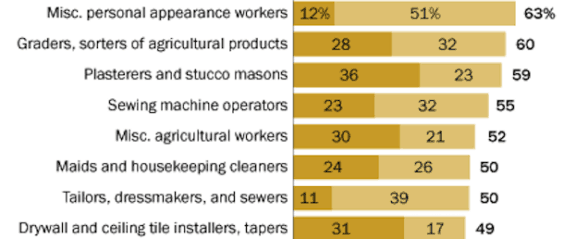A New Slant
Brookings has an interesting analysis on labor US productivity trends. Labor productivity = the amount of goods and services a worker produces per hour of work. The bad news: productivity since 2004 is decreasing. Economists have been debating the origins and outcomes of this trend for a while now. This report, which is very readable, looks at productivity across different metropolitan regions. Some highlights:
- Average labor productivity averaged $113,000 per worker in 2015. Jacksonville, NC was at the low end of the range at $38,000. Midland, TX was high at $299,000. (Thank you, oil.)
- Larger metros areas were more around 17% more productive than small metro areas and non-metro areas.
- Productivity has slowed in recent year. Productivity growth was more than 3% annually from 1948-1973 and 1995-2004. 1973-1995 saw a decrease to 1.6%. The growth was 1.3% from 20014-2015.
- Metros seeing higher growth in productivity had deep connectivity in the energy or technology sectors or housed major universities. Durham-Chapel Hill fell into the latter camp.
- Not surprisingly, Metro areas with higher labor productivity tend to also have higher incomes and lower poverty rates.
Dropping Knowledge
As the North Carolina General Assembly considers legislation about digital infrastructure, we enjoyed a recent report from the Federal Communications Commission on access to Internet connections across the U.S. The report will not win any design awards, but it is a quick skim and a manageable read. Some highlights:
- Between December 2012 and December 2015, the number of internet connections has risen from from 262.6 million to 355.2 million, with roughly 70 percent being wireless connections.
- Fixed connections–connections that are hard wired to a residence or business–are increasing in speed. The FCC suggests that the connection speed required to view standard feature videos is 1.5 megabit per second (mps), with High Definition video requiring 4 mps. Of the 102.2 million fixed connections in 2015, only 5.8 million were slower than 3 mps. That is down from 19.2 million in 2012.
- Citizens’ options to choose between providers is strong at slower speeds but decreases at the faster speeds. 95 percent of U.S. blocks have more than one provider option for a fixed connection of at least 3 mps. For speeds greater than 10 mps, 47 percent of residences have one provider option and 29 percent of residences have no providers
Food for Thought
The Milken Institute released a report on the Best Cities for Successful Aging. It is a rankings document, which makes it dubious, but there is solid transparency into the methodology and a reasonable policy message undergirding the effort. There general ratings areas were (1) safety, living option and affordability, (2) health and wellness, (3) financial security and work opportunities, (4) mobility, and (5) cultural engagement. In addition, the report highlights best practice aging programs that it uncovered during its research. That alone is worth a skim for inspiring ideas on ways to serve our aging population.
The report ranked 4 NC metro areas as part of the country’s 100 large metro areas:
- Durham-Chapel hill is ranked the 3rd best city for successful aging. Provo, UT and Madison, WI were 1st and 2nd.
- Raleigh was 42nd.
- Greensboro-High Point was 89th.
- Winston-Salem was 95th
In the small metros categories, 9 NC metros were ranked in the 281 metros surveyed.
- Greenville was 44th
- Wilmington was 160th
- Fayetteville was 165th
- Jacksonville was 183rd
- Asheville was 200th
- Goldsboro was 210th
- New Bern was 240th
- Rocky Mount was 244th
- Hickory was 247th
What we're reading
Immigrants don't make up the majority of workers in any US industry
Immigrants are more likely than U.S.-born workers to be employed in certain jobs, including sewing machine operators and stucco masons. But there are no major U.S. industries in which immigrants outnumber the U.S. born.... Read the rest-
The Conversation: Why we should not know our own passwords
-
Harder high school classes may improve college success
-
When Schooling Doesn’t Mean Learning
-
What is a robot exactly – and how do we make it pay tax?
-
The American States and the Autonomous Auto Conundrum
-
How Living Structures Can Better Protect Our Coastline


